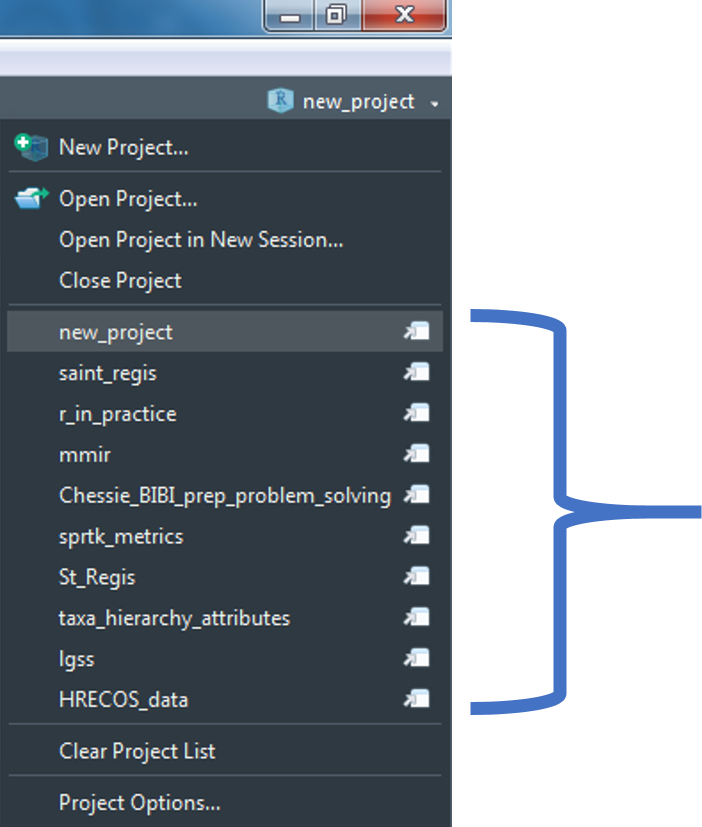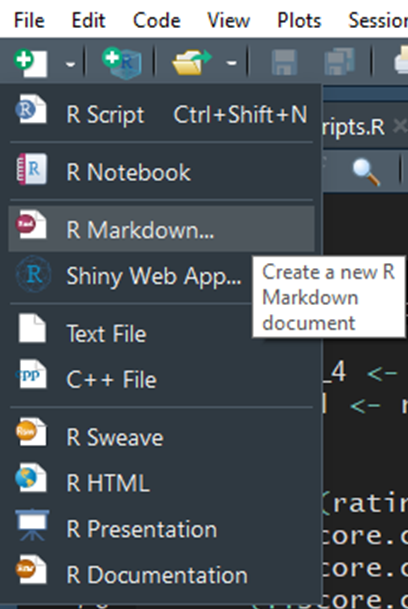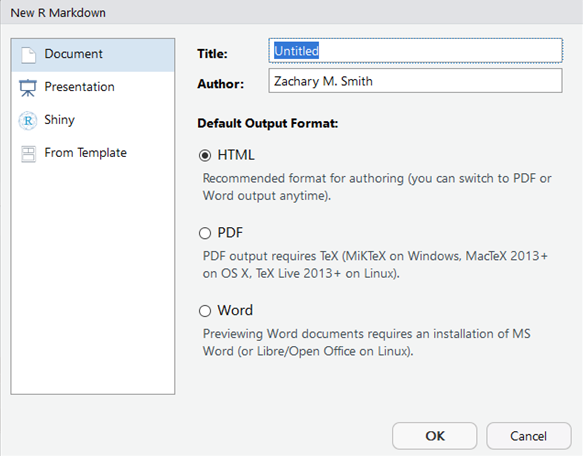99 Efficient Workflow with R Projects and R Markdown
99.1 Overview
Are you ready to make your data analysis smoother and more efficient? R Projects and R Markdown provide a potent combination that streamlines data analysis and reporting in R. Combining R Projects with R Markdown is like having a Swiss Army knife for your R environment—it integrates perfectly with version control systems like Git and keeps your file paths consistent, no matter where you move your projects. This lesson will show you how to set up an R Project, organize your files, and create an R Markdown document to streamline your data analysis workflow. This section takes heavy inspiration from Zachary M. Smith.
99.2 R Projects: Your Workspace Anchor
R Projects establish a self-contained environment for any data analysis project. They help in organizing your work and ensuring that file paths are consistent, making your work portable and easier to share with collaborators.
99.2.1 Create a New R Project
Start New Project: In RStudio, create a new R project by clicking on the drop-down menu in top right of your window and selecting “New Project”
Select “New Directory” within the “Create Project” window
Select “New Project” within the “Project Type” window
Enter a project name (below I have given the name “new_project”), the project directory (where the project should live), and select “Create Project”
Tip: Create a “project” folder that will act as your parent directory for all R projects. This will make it much easier to navigate to and between projects.
A new session specific to your R project will start within RStudio
- There are a number of ways to tell which project is open…
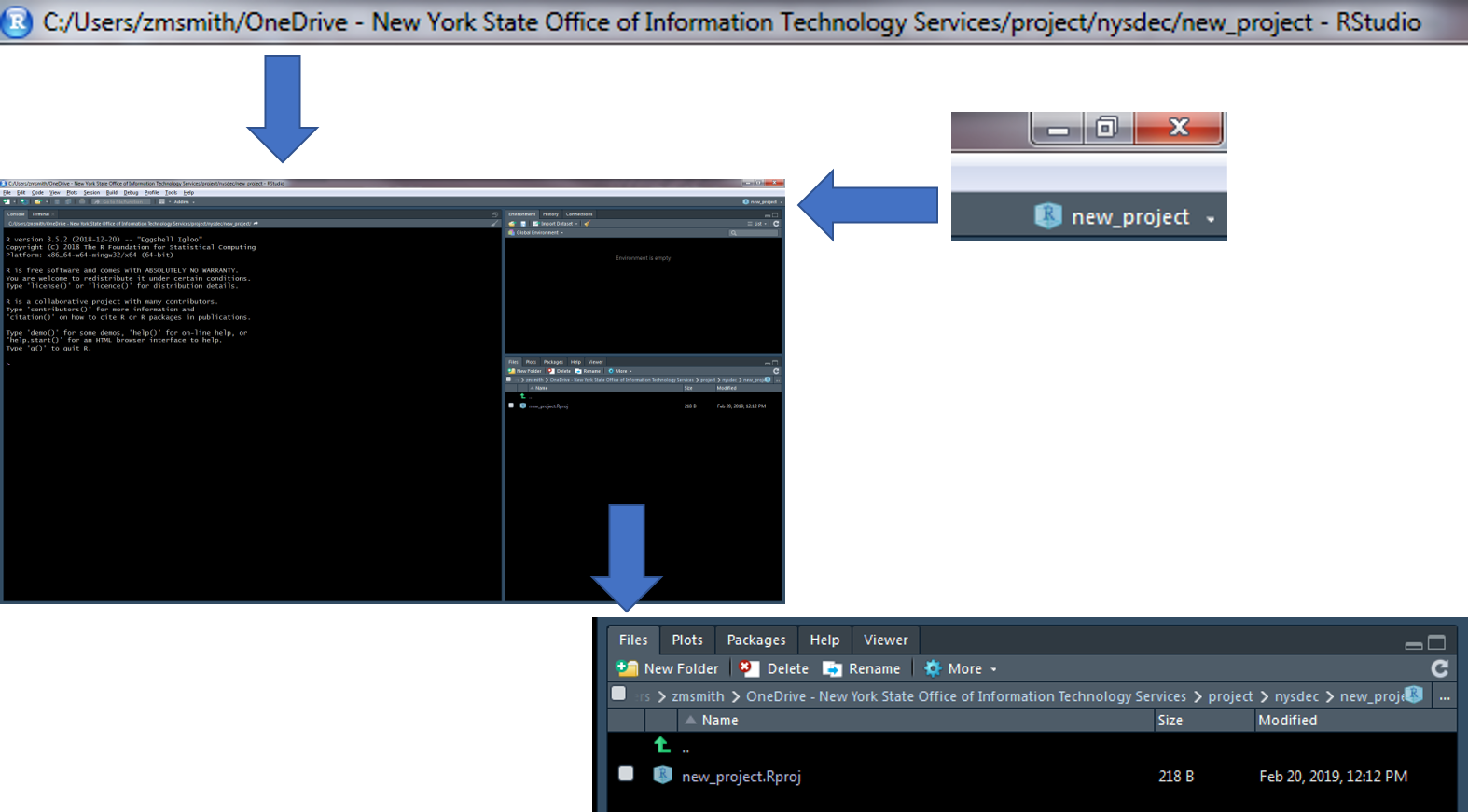
99.4 Recommended Workflow
- Set up a GitHub repository.
- Create an R-project connected to the GitHub repository.
- Develop R-scripts.
- Push and pull project changes to and from GitHub.

99.5 Your Turn
Open R Studio.
Create a new Project.
Add an “data” folder and add the example data set to this folder.
Create a new R Script (Ctrl + Shift + N) and save the script as “lesson_1.R” to your project root folder.
Add the following script and run it (Ctrl + Enter)
- Notice that the entire file path to CSV of interest (“zms_thesis_metrics.csv”) was not specified just
file.path("data", "zms_thesis_metrics.csv").
- Notice that the entire file path to CSV of interest (“zms_thesis_metrics.csv”) was not specified just
View
df_thesisin the Environment panelHow many rows and columns does our data frame have?
Click on the drop-down menu (the blue circle to the left of
df_thesis).- Can you identify the column type (e.g., Character, Numeric, Integer, or Factor) of the columns
unique_id,substrate_size_d50,richness, andpct_diptera? - What are the first, second, and third
unique_id’s represented in the data frame and whichrichnessvalues are associated with eachunique_id?
- Can you identify the column type (e.g., Character, Numeric, Integer, or Factor) of the columns
Click on the button to view the data (the small girdded table to the far-right of
df_thesis)- Filter the data frame to only see data from Onondaga Lake (
lake= “onon”)
- Filter the data frame to only see data from Onondaga Lake (
99.7 Compile the Document

To view the html document, you must compile the document using Knit. The easiest way to knit a document is to navigate to and click on the Knit button (it looks like a ball of yarn) in the toolbar above the editor window. If a window appears saying “Install Required Packages” for R Markdown, install the necessary packages for knitting the document. The compiled file will be saved in the same directory as your Rmd file (your R Markdown file). I generally store the R Markdown file(s) in a sub-directory labeled “rmarkdown” within the R-project folder (rproject/markdown), which prevents the project directory from becoming cluttered– this is NOT necessary.
You can click on the small triangle to the right of the Knit button to view a drop-down menu of knitting options. Here you have the option to update the document type you want to knit (examples listed below).
- Knit to HTML
- Knit to PDF
- Knit to Word
By clicking one of these options your YAML header updates automatically. We will discuss YAML headers in a later section, but in short the YAML header defines some of the formatting options associated with the document, including the output type. You can have multiple document types render at once (e.g., a separate HTML and Word document are created with each knit call).
99.8 Document Types
There are multiple document types available which designate how the .Rmd file will be rendered (knit).
99.8.1 HTML
Knitting to a Hyper Text Markup Language (HTML) document is the default for R Markdown. Using HTML will enable you to add interactive features to your document. To view HTML documents, simply open them in your internet browser of choice– by default, your machine should open HTML documents in your default browser automatically.
99.8.1.1 R Markdown vs. R Notebook
R Markdown documents (html_documents) and R Notebook documents (html_notebook) are very similar; in fact, an R Notebook document is a special type of R Markdown document. The main difference is using R Markdown document (html_documents) you have to knit (render) the entire document each time you want to preview the document, even if you have made a minor change. However, using an R Notebook document (html_notebook) you can view a preview of the final document without rendering the entire document.
For all document types you can specify how you want to preview the rendered documents by clicking on the cog in the Source window toolbar to reveal a drop-down menu of options. The recommended setup for use of an R Notebook document would be to specify you want to view the preview in the Viewer pane (i.e., the bottom right pane shared with Files, Plots, Packages, and Help).
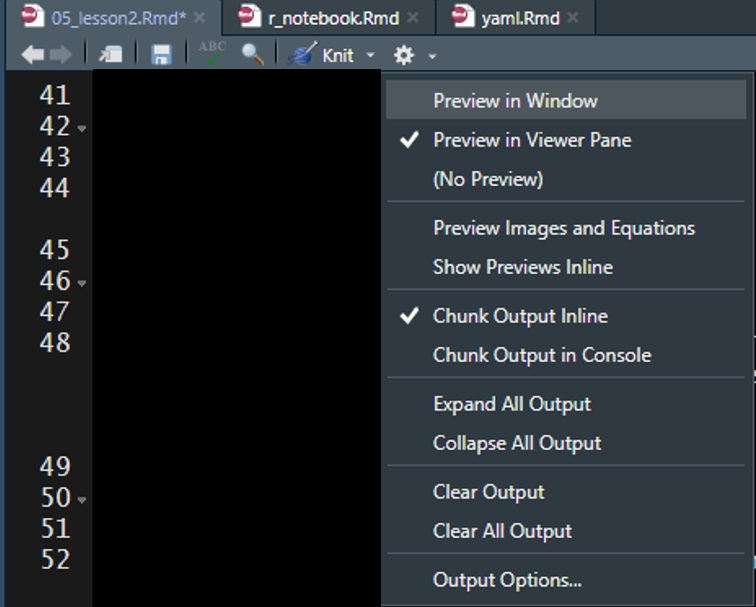
Then click on the “Preview” button in the Source window toolbar to render a preview of the final document.

Keep the Viewer pane open and do not close the preview of the document. Now begin to edit the markdown syntax in the document. Each time you save the document the preview window will render the changes made to the markdown syntax. If you edit R code chunks, you must run the code chunks within the notebook file prior to saving to see the changes in the Viewer window.
99.8.2 PDF
You have the ability to knit to Portable Document Format (PDF) but you will not be able include interactive features in the document. Knitting to a PDF requires you to have the program LaTeX installed. You will get the following error message if you try to knit a PDF document without LaTeX installed on your machine: > No LaTeX installation detected (LaTeX is required to create PDF output). You should install a LaTeX distribution for your platform: https://www.latex-project.org/get/ If you are not sure, you may install TinyTeX in R: tinytex::install_tinytex() Otherwise consider MiKTeX on Windows - http://miktex.org MacTeX on macOS - https://tug.org/mactex/ (NOTE: Download with Safari rather than Chrome strongly recommended) Linux: Use system package manager
99.8.3 Word
You have the ability to knit to Microsoft Word if you have Microsoft Word installed on your machine. Similarly to PDFs, you will not be able to include interactive features in your Word documents.
99.8.4 Templates
99.8.4.1 Provide Templates
There are a number of templates you can install or will come with packages you install, which you can view in the pop-up window that appears when you select that you want to create a new R Markdown file.
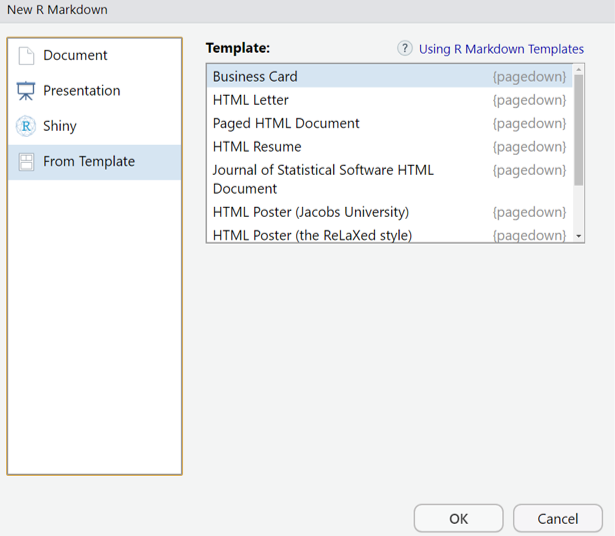
These templates may give you a jump-start to provide a large portion of the formatting specification to make specific documents. Some example templates from the package pagedown are:
- Business Card
- Letter
- Paged HTML Documents
- Resume
- Journal Article
- Poster
- Thesis
- Package Vignette
99.8.4.2 Custom Templates
You also have the ability to specify custom templates in your YAML header. We will discuss YAML headers in a later section (Lesson 4: YAML Headers).
I have only used this feature for Microsoft Word documents. I created a new document within Microsoft Word and selected all of the formatting options I wanted for my document. I then added the template to the YAML header of my R Markdown document to specify that when the document is knit (rendered) to apply the formatting specifications found in the template Microsoft Word document.
99.8.5 Other Types
99.8.5.1 Presentations
You have the ability to create presentation slides using R Markdown. Below are the different format options available. Examples can be found in the following link under the “Presentation” section: https://rmarkdown.rstudio.com/gallery.html
- ioslides (HTML)
- Slidy (HTML)
- Beamer (PDF)
- Requires LaTeX
- Microsoft PowerPoint
- Requires Microsoft PowerPoint
I have tried to create presentations with R Markdown on several occasions but I always revert back to using Microsoft PowerPoint. I have not found these slides to be very flexible and seem to only be able to generate simple slides without much content. My recommendation would be to try these slides out if you are making a presentation demonstrating how to use simple R code.
99.9 Your Turn
Create a new HTML .Rmd file.
Save the document to your project root folder.
Knit the default document produced by RStudio.
Using the Knit drop-down menu, specify that you want to create a Word document.
- This will only be possible if you have Microsoft Word installed on your machine.
Bonus: Try creating new R Markdown documents and selecting Presentation, Shiny, and other templates available. Each selection will provide you with an example .Rmd file that you can knit (render) and explore.
